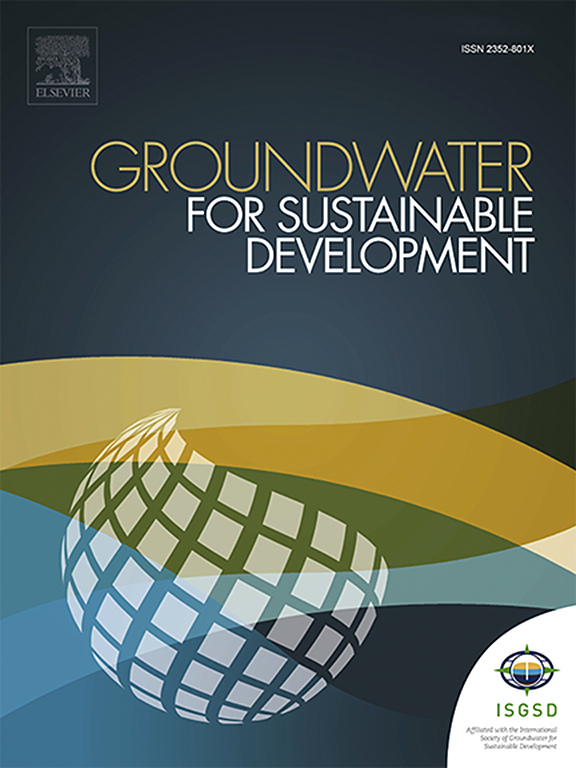Sustainable adsorbents: Metal oxide-biochar nanocomposites from Maize Stalks and Wild Tamarind residues for dye removal and phytotoxicity assessment
IF 4.9
Q2 ENGINEERING, ENVIRONMENTAL
引用次数: 0
Abstract
Environmental pollution arising from textile dye-based wastewater poses a significant concern within the industrial and scientific communities, given its profound impact on ecosystems. This study focuses on enhancing decontamination capabilities and broadening the scope of constructed wetlands. The study explores the potential of constructed wetland substrates that incorporate Wild Tamarind -mediated metal oxide-coated biochar for the removal of Reactive Golden Yellow-145 (RY-145) dye. Characterizations were conducted using Scanning Electron Microscopy, Brunauer–Emmett–Teller and Fourier Transform Infrared Spectroscopy. Optimization of various operational parameters were carried out. Results revealed that CuO-CBC (83.15 mg g−1), MgO-CBC (79.24 mg g−1), ZnO-CBC (69.20 mg g−1), MnO2-CBC (65.01 mg g−1), and CBC (54.72 mg g−1) demonstrated the highest adsorption capacities. The analysis included various isotherms, kinetics, and thermodynamic models. Maximum desorption was also achieved. The study also assessed the potential efficacy of nano-adsorbents in removing dye from real textile effluent and conducted phytotoxicity investigation on Pea seeds and Lemongrass to evaluate their environmental sustainability. Constructed wetlands exhibited higher removal efficiency compared to batch adsorption when incorporating green nano-biochar composites as substrates. Therefore, these promising green adsorbents hold significant potential for dye adsorption and serve as substrates for wetlands, contributing to the treatment of textile wastewater.

可持续吸附剂:用于染料去除和植物毒性评估的玉米秸秆和野生罗望子残基金属氧化物-生物炭纳米复合材料
鉴于纺织染料废水对生态系统的深远影响,其产生的环境污染引起了工业界和科学界的重大关注。本研究的重点是提高人工湿地的去污能力和扩大人工湿地的范围。该研究探索了人工湿地基质中含有野生罗望子介导的金属氧化物包覆生物炭去除活性Golden huang -145 (RY-145)染料的潜力。利用扫描电镜、布鲁诺尔-埃米特-泰勒和傅里叶变换红外光谱对其进行了表征。对各种操作参数进行了优化。结果表明,CuO-CBC (83.15 mg g−1)、MgO-CBC (79.24 mg g−1)、ZnO-CBC (69.20 mg g−1)、MnO2-CBC (65.01 mg g−1)和CBC (54.72 mg g−1)的吸附量最大。分析包括各种等温线、动力学和热力学模型。解吸也达到了最大值。研究还评估了纳米吸附剂去除纺织废水染料的潜在功效,并对豌豆种子和柠檬草进行了植物毒性研究,以评估其环境可持续性。以绿色纳米生物炭复合材料为基质的人工湿地与批量吸附相比,具有更高的去除效率。因此,这些有前途的绿色吸附剂在染料吸附和作为湿地基质方面具有很大的潜力,有助于处理纺织废水。
本文章由计算机程序翻译,如有差异,请以英文原文为准。
求助全文
约1分钟内获得全文
求助全文
来源期刊

Groundwater for Sustainable Development
Social Sciences-Geography, Planning and Development
CiteScore
11.50
自引率
10.20%
发文量
152
期刊介绍:
Groundwater for Sustainable Development is directed to different stakeholders and professionals, including government and non-governmental organizations, international funding agencies, universities, public water institutions, public health and other public/private sector professionals, and other relevant institutions. It is aimed at professionals, academics and students in the fields of disciplines such as: groundwater and its connection to surface hydrology and environment, soil sciences, engineering, ecology, microbiology, atmospheric sciences, analytical chemistry, hydro-engineering, water technology, environmental ethics, economics, public health, policy, as well as social sciences, legal disciplines, or any other area connected with water issues. The objectives of this journal are to facilitate: • The improvement of effective and sustainable management of water resources across the globe. • The improvement of human access to groundwater resources in adequate quantity and good quality. • The meeting of the increasing demand for drinking and irrigation water needed for food security to contribute to a social and economically sound human development. • The creation of a global inter- and multidisciplinary platform and forum to improve our understanding of groundwater resources and to advocate their effective and sustainable management and protection against contamination. • Interdisciplinary information exchange and to stimulate scientific research in the fields of groundwater related sciences and social and health sciences required to achieve the United Nations Millennium Development Goals for sustainable development.
 求助内容:
求助内容: 应助结果提醒方式:
应助结果提醒方式:


